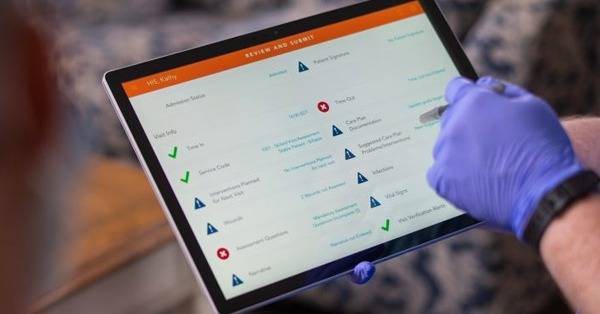- Solutions
- Solutions
- Home Health
- Hospice
- Life Plan Community
- Palliative Care
- Private Duty
- Senior Living
- Skilled Nursing
- Skilled Nursing
- Skilled Nursing Software
- Advanced Insights
- Customer relationship management
- Data and analytics
- Financial & operations management
- Marketing
- Nutrition management
- Referral management
- Regulatory compliance
- Retail management
- Resident engagement
- Revenue cycle management
- Skilled nursing interoperability
- Partners
- Blogs
- Resources
- About
- User Conference

5 ways interoperability can benefit skilled nursing facilities
The dramatic changes in technology brought by the digital age have made life easier for healthcare providers everywhere. Health records have transformed into collections of electronic data, simplifying administration processes. That’s the theory, anyway. The reality is something different.
In practical terms, real life hasn’t caught up to the hype. Communication between providers can still suffer rough patches. That’s why interoperability is crucial to the future of healthcare. Skilled nursing facilities (SNF) are no exception—in fact, they stand to benefit the most from compatible electronic health record systems.
Even though many SNFs are falling behind when it comes to interoperability, there are plenty of reasons why they should address this need. Here are five key ways interoperability can benefit skilled nursing facilities:
Enhanced relationships with referral sources
The majority of post-acute referral sources already communicate secure resident data electronically to providers. Because simplifying that exchange should always be a priority, adopting compatible technology becomes a no-brainer. When referral sources choose a provider, they will prefer the option to seamlessly send and receive data on residents. Having the technology that allows your care centers to interoperate like this will set you apart from the competition.
But that’s not the only reason to improve the ability of your systems to communicate. You’ll also make daily tasks less tedious for your people. Managing stacks of paper—including referrals, eSignatures, point-of-care documentation, and real-time resident data—can now be performed and organized electronically. This makes it easy for your full professional and interdisciplinary team to access critical health information during and after admission.
More efficient operations
It’s always important to see a return with any technology investment in your care centers, for everything from computers to medical equipment. Interoperability provides a clear return. Sending and receiving data electronically means fewer documents, less effort searching for resident records, less time communicating with providers, and more immediate information.
This increased visibility of resident information also can improve resident-centered care. This can come in a variety of ways: more informed care plans, thorough documentation, greater likelihood of approved claims, and full reimbursements. Interoperability will ultimately minimize waste of both time and paper, which means you can spend more time with more residents. And you’ll enjoy a favorable boost to your bottom line as well as the well-being of your employees.
Valuable productivity gains
With a more efficient system comes a better process. Earlier we mentioned the benefit of sparing your staff the tedium of paperwork; all that time saved on administrative tasks can be spent instead with residents, providers and referral sources. There is a chance to be not just more productive, but proactive as well.
Many care centers fear technology replacing jobs, but it actually can enhance many roles—from front-of-office workers to point-of-care staff. It also allows them to focus on what is important, like providing fully informed care, selecting the right resident records, and conducting accurate documentation.
Improved experience for residents and families
All these benefits come together to create a better experience for both residents and their families. More efficient processes allow for more time with residents, and improved communication means data gets shared quickly and accurately. Simply put, trusted providers stay connected, which leads to better care.
When providers and care staff are fully informed, working together, and sharing data electronically, residents and their families are more likely to be satisfied and trust their care centers.
Necessary preparations for the future
Whether or not you want to embrace technology, it’s here to stay. You can choose to take advantage of opportunities to enhance your business and maintain strong connections to other providers. By adopting interoperability technology now, you can differentiate your care centers and be an industry leader as we all move toward an even more connected future.
Disclaimer
The content in this presentation or materials is for informational purposes only and is provided “as-is.” Information and views expressed herein may change without notice. So, we encourage you to seek, as appropriate, regulatory, and legal advice on any of the matters covered in this presentation or materials.
See what MatrixCare can do for you
Amy Ostrem
Amy Ostrem, Vice President, Strategy & Portfolio Management, has been working with our products and service teams for more than 2 decades. She originally was a client before joining the company as a Client Education Consultant and has served in various departments and roles through her tenure. In her current role, she divides her time between client communications, client service teams, sales enablement, and product development teams. Ostrem oversees the Product Strategy, Value Proposition, Commercialization, Product Managers, and Business Analysts. She participates in industry events, client engagement sessions, focus groups, our annual Inspire event, and presents regularly at provider advisory boards. Ostrem holds a bachelors degree from Concordia College in Healthcare Financial Management.
Related Posts


See MatrixCare in action
Start by having a call with one of our experts to see our platform in action.
MatrixCare offers industry-leading software solutions. Thousands of facility-based and home-based care organizations trust us to help them improve efficiency and provide exceptional care.
© 2025 MatrixCare is a registered trademark of MatrixCare. All rights reserved.






